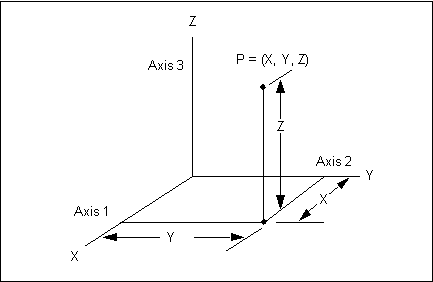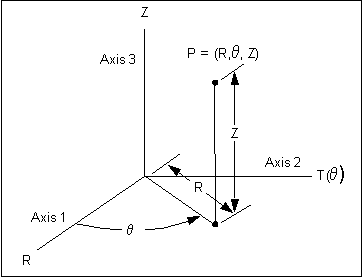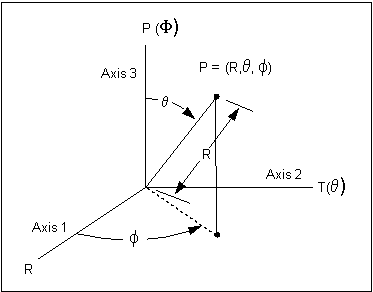XXXXXXXXXXXXXXXXXXXXXXXXXXXXXXXXXXXXXXXXXXXXXXXXXXXXXXXXXXXXXXXXXXXXXXXXXXXXXXXXXXXXXXXXXXXXXXXXXXXXXXXXXXXXXXXXXXXXXXXXXXXXXXXXXXXXXXXXXXXXXXXXXXXXXXXX''"> Coordinate Frame Definitions
Patran can create and support three types of coordinate frames:
• Rectangular (X,Y,Z)
• Cylindrical (R, Theta, Z)
• Spherical (R, Theta, Phi)
Patran also has a default global rectangular coordinate frame, Coord 0. Coord 0 is the default reference coordinate frame for many application forms (which can be changed to another coordinate frame). Also, Coord 0 cannot be deleted, even if specified.
Each coordinate system defined in Patran has three principal axes. These axes define how spatial locations are determined in that coordinate system, and are internally numbered 1, 2 and 3. The meaning of each principal axis depends on if the coordinate frame is rectangular, cylindrical or spherical.
When a coordinate frame is created, its principal axes and its orientation are displayed at the appropriate location on the model. The ID of the coordinate frame is also displayed at the coordinate frame’s origin.
Important: | Coordinate frame angles for the cylindrical and spherical coordinate frames (that is,  and  ) are expressed in degrees. Special conditions apply when defining spatial functions in cylindrical or spherical coordinate frames. For more information, see Procedures for Using Fields (p. 189) in the Patran Reference Manual. |
Rectangular Coordinate Frame
Figure 3‑1 shows the principal axes of a rectangular coordinate frame and a point,
P, in rectangular space. In a rectangular frame, the principal axes 1, 2 and 3 correspond to the X, Y and Z axes, respectively. Points in space specified in a rectangular coordinate frame are entered in the order: x-coordinate, y-coordinate and z-coordinate.
Figure 3‑1 Rectangular Coordinate Frame
Cylindrical Coordinate Frame
Figure 3‑2 shows a cylindrical frame in which the principal axes 1, 2 and 3 correspond to the R, T
( )
) and Z axes, respectively. Points specified in a cylindrical coordinate frame are entered in the order: radial-coordinate, theta-coordinate and z-coordinate.
Figure 3‑2 Cylindrical Coordinate Frame
Spherical Coordinate Frame
Figure 3‑3 shows a spherical frame in which the principal axes 1, 2 and 3 correspond to the R, T
( )
) and P
( )
) axes, respectively. Points specified in a spherical coordinate frame are entered in the order: radial-coordinate, theta-coordinate, and phi-coordinate.
A node’s local directions (1, 2, 3) can vary according to its position within the spherical coordinate frame. For example:
If node lies along R direction, then dir 1 of node is along +R |
If node lies along R direction, then dir 2 of node is along -P |
If node lies along R direction, then dir 3 of node is along +T |
If node lies along T direction, then dir 1 of node is along +T |
If node lies along T direction, then dir 2 of node is along -P |
If node lies along T direction, then dir 3 of node is along -R |
If node lies along P direction, then dir 1 of node is along +P |
If node lies along P direction, then dir 2 of node is along +T |
If node lies along P direction, then dir 3 of node is along -R |
Figure 3‑3 Spherical Coordinate Frame Definition
 and
and  ) are expressed in degrees. Special conditions apply when defining
) are expressed in degrees. Special conditions apply when defining

